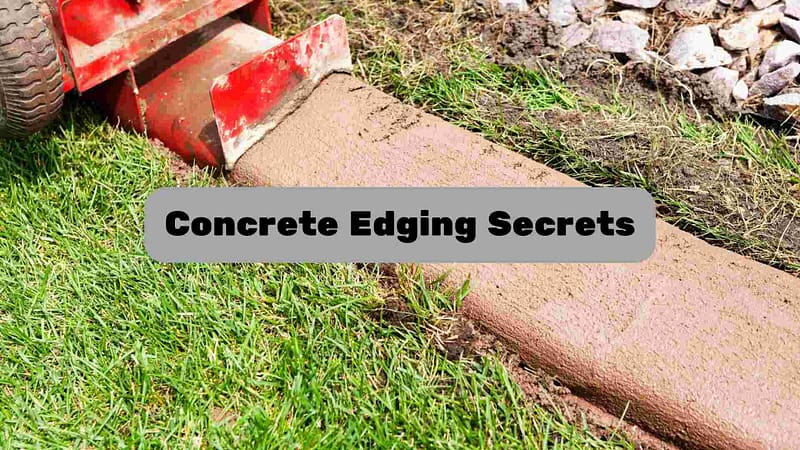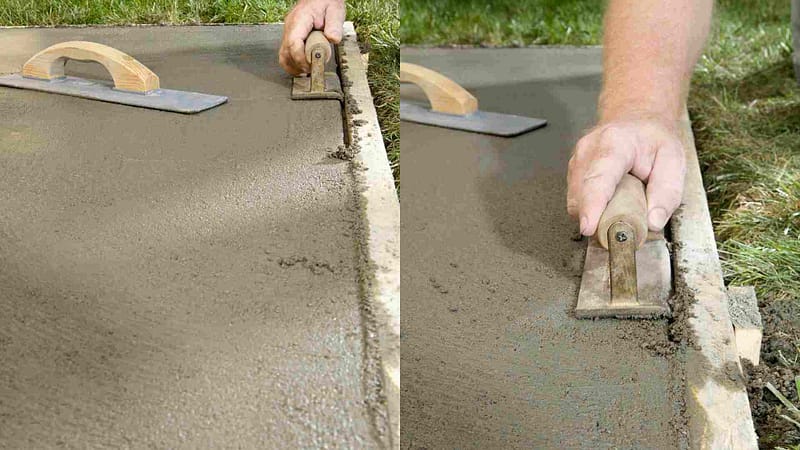In the world of landscaping design & remodeling, the strategic use of concrete edging can not only define the borders of gardens and walkways but also enhance the aesthetic appeal of outdoor spaces. This article delves into various concrete edging ideas, exploring their practicality and versatility in garden design. From the different styles that can complement your outdoor area to the technical aspects of installation, concrete edging ideas are a focal point in achieving a neat, professional finish.
Whether you’re considering the durability of such installations or pondering the specific techniques on how to lay concrete edging effectively, this guide offers valuable insights and expert tips. Moreover, concrete edging ideas can provide a durable solution that withstands the test of time, making it a worthwhile investment for homeowners seeking to deliver quality concrete work.
Table of Contents
Repairing Severely Damaged Hardwood Floors: A Comprehensive Guide
Concrete edging is a versatile and durable option for creating crisp, clean lines around garden beds, lawns, and walkways. This method of landscaping not only helps in maintaining the tidiness of outdoor spaces but also adds a structured look that can enhance the overall design of your garden. In this section, we explore ten innovative concrete edging ideas and tips that cater to a variety of styles and practical needs. Each idea is designed to inspire homeowners and garden enthusiasts to think creatively about the borders of their outdoor spaces.
Curved Edges: Implementing curved concrete borders can soften the hard lines of rectangular lawns and garden beds, adding an element of surprise and visual interest.
Colored Concrete: Adding pigment to the concrete mix can help coordinate your edging with other elements in the garden, such as pavers, garden furniture, or plant colors.
Textured Edges: Use stamps or molds to create textured concrete edges, which can mimic natural stone, brick, or even intricate lace patterns, providing a unique aesthetic touch.
Raised Borders: Construct raised concrete borders to add depth and dimension to flat gardens. These can also double as informal seating around garden beds or fire pits.
Lighting Integration: Embedding low-voltage LED lights within the concrete edging offers both practical nighttime visibility and an enchanting evening ambiance.
Mosaic Tiling: Embedding tiles, stones, or colored glass pieces into the top layer of wet concrete can create a striking mosaic effect that catches the eye and adds artistic flair.
Intermittent Patterns: Instead of a continuous concrete edge, consider placing intermittent concrete blocks interspersed with grass or gravel. This modern look helps in reducing material usage while maintaining a clean boundary.
Incorporating Steps: If your garden sits on a slope, integrating steps within the concrete edging can enhance accessibility while maintaining a coherent design.
Low Walls: Utilize concrete edging to form low walls around planters or to delineate different sections of your garden, such as separating the vegetable patch from ornamental areas.
Eco-Friendly Options: Use recycled concrete or add sustainable materials like crushed glass to the concrete mix, reducing environmental impact while achieving a distinctive look.
Concrete edging is more than just a practical landscaping tool—it’s an opportunity to creatively enhance the aesthetic appeal and functionality of outdoor spaces. With the right ideas and techniques, such as those outlined above, you can transform a simple garden into a structured and stylish sanctuary. The choice of materials for your outdoor areas can be quiet challenging. In this case concrete is easily one of the best choices you can take.

Is Concrete Edging Worth It?
Concrete edging is highly beneficial for its durability and low maintenance, making it a cost-effective choice for garden delineation. It not only enhances landscape aesthetics but also increases property value, effectively containing garden materials and reducing the intrusion of weeds into lawn areas.
Durability and Maintenance
Concrete edging is celebrated for its exceptional durability. It withstands harsh weather conditions, resists cracking, and doesn’t decay like wood or erode like metal. This resilience makes it a long-lasting solution, effectively reducing the frequency and costs associated with garden border maintenance. Wether you choose concrete for your basement flooring, your driveways & patios or your garden, you know it will stand the test of time.
Aesthetic and Functional Benefits
From an aesthetic standpoint, concrete edging offers a clean, crisp look that can be tailored to fit any garden style. It is available in various colors and textures, allowing customization that complements your home’s exterior. Functionally, it serves as a robust barrier, preventing the spread of grass and stabilizing paving stones, which simplifies mowing and trimming tasks. This dual functionality not only enhances the garden’s appearance but also contributes to its overall health and ease of care.
Cost-Effectiveness and Property Value
While the initial investment in concrete edging might be higher than some alternatives, its longevity and minimal upkeep make it a cost-effective choice over time. Moreover, well-maintained garden edges can increase a property’s curb appeal and, consequently, its market value. A studies suggests that landscaping improvements, including edging, can increase home resale value by up to 7%. This statistic underscores the practical financial benefits of opting for durable, attractive concrete edging in home landscaping projects.

Optimal Depth for Concrete Edging Installation
The recommended depth for concrete edging typically ranges between 4 to 6 inches. This depth ensures stability and provides adequate barrier against grass roots, preventing them from encroaching into garden beds. It's essential for supporting the edging's weight and withstanding environmental pressures, especially in areas with severe weather or heavy soil movement.
Installing concrete edging at the recommended depth of 4 to 6 inches is vital for both its functionality and longevity. This specific depth range is ideal because it provides ample support for the edging’s weight and ensures it remains stable against environmental pressures like soil movement and severe weather. Shallow installations may lead to the edging shifting over time and becoming less effective as a root barrier, while excessively deep installations could waste materials and unnecessarily increase costs.
Additionally, the chosen depth acts as an effective deterrent against root intrusion, keeping garden beds distinct and preventing lawn grass from encroaching. Local soil conditions and climate can influence the optimal depth for concrete edging. For instance, in areas prone to heavy freeze-thaw cycles, a slightly deeper installation might be required to counteract soil heaving. Conversely, in regions with stable, mild weather, the minimum depth may be entirely adequate. Consulting with a landscaping expert who understands local conditions can ensure that the depth of your concrete edging meets both practical needs and aesthetic goals effectively.
Step-by-Step Guide to Laying Concrete Edging
To lay concrete edging effectively, first prepare a trench about 6 inches deep and wide. Mix and pour concrete into the trench, ensuring it's level and smooth. Reinforce with steel if needed for extra stability. Allow it to cure fully before backfilling with soil. This method secures the edging and ensures long-term durability.
Preparation and Setup
The first step in laying concrete edging is to prepare the site by marking out the area where the edging will be placed. A trench should then be dug to the recommended depth and width, typically around 6 inches. This preparation ensures that the edging will have enough space to be both stable and effective as a boundary. The ground within the trench must be compacted and leveled, providing a solid base for the concrete.
Mixing and Pouring Concrete
After preparation, concrete is mixed according to manufacturer’s instructions to achieve the right consistency. The mixed concrete is then poured into the trench, making sure it fills all corners and is free from air pockets. It’s crucial to smooth the top surface with a trowel and ensure it aligns well with the landscape design. For areas that require additional strength, such as curved sections or corners, steel rebar or mesh can be embedded within the concrete to reinforce it.
Curing and Finishing Touches
Once poured, the concrete needs to be allowed to cure slowly to gain maximum strength. This process can take several days, during which the concrete should be kept moist to prevent cracking. After curing, the area around the new edging can be backfilled with soil or finished with sod or decorative stones, integrating the new edging seamlessly into the garden. Proper curing and finishing not only enhance the durability of the edging but also its aesthetic appeal, blending it into the surrounding landscape.
Conclusion
In conclusion, concrete edging offers a blend of durability, aesthetics, and functionality, making it an excellent choice for garden and landscape design. Whether you’re considering its cost-effectiveness, exploring the depth needed for stability, or learning about the proper techniques for laying it, concrete edging proves to be a worthwhile investment.
Each aspect, from choosing the right depth to understanding the installation process, plays a crucial role in ensuring that the edging not only looks good but also performs its function efficiently over time. By following the guidelines and expert tips provided, homeowners can enhance their property’s curb appeal and enjoy a well-defined, low-maintenance landscape that stands the test of time.






